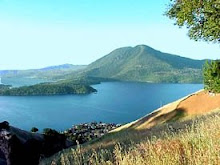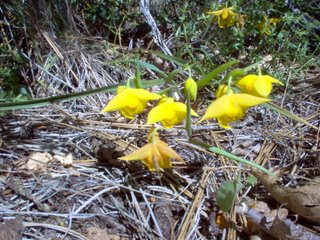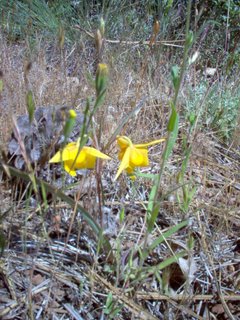My Questions and a Reply from MadSci Network
Calochortus amabilis,commonly known as Diogenes Lantern, grows only in California. I wish to learn the pollinators of this plant and why the flower turns red/orange after pollination occurs (Does this coloration discourage pollinators from visiting an already pollinated flower? The red color of autumn Maple leaves is the result of stored sugars. Is the red I see in the Calochortus amabilis flower also the result of stored sugars? Does this red color discourage insects, animals, or birds from eating the ripening ovary?) Why are there “hairs” on the petals of members of the Calochortus family? Do these hairs brush pollen grains off visiting insects and thus increase the chances of successful pollination? Is being a “Generalist” as opposed to attracting “specific pollinator” actually a good thing? In years when one population of pollinators suffers ( such as the honey bee being attacked by parasitic mites) is the Calochortus amabilis population able to maintain as it still attracts other pollinators (such as beetles)?
The reply from MadSci:
Your question was answered by:David Hershey Faculty, Botany, NAYou ask several interesting questions that may not have been researched. Thefirst reference indicates that most Calochortus are generalists in regard toinsect pollinators. You might wish to email the authors with your questions andto ask for a copy of their Calochortus articles.
It seems likely that a generalist plant species for pollinators would have anadvantage over a specialist species in certain situations. If the specialistspecies lost its only pollinator, it could be in deep trouble. Losing a singlepollinator species for a generalist plant species would not be as serious. Onthe other hand, a specialist plant species might have a more efficientpollinator than a generalist plant species.
To test your hypothesis of why the flower turns red/orange after pollination.Take some cut Calochortus flowers indoors before they open and place them whereinsects cannot get at them. As a control, hand pollinate some cut flowers. Ifthey do not turn red/orange in unpollinated, then you can establish thatpollination causes the change. An alternative explanation is that the red/orangecolor develops due to senescence whether or not the flower is pollinated.
Your questions on whether the red/orange color is due to stored sugars would bemore difficult to test. It might require biochemical work. First, you would haveto identify the red/orange pigments. It may be an anthocyanin, which are thesame type of pigments that are produced in autumn tree leaves as a "sunscreen"(see second reference).
References
Lee, D.W. and Gould, K.S. Why leaves turn red. American Scientist 90: 524-531.





